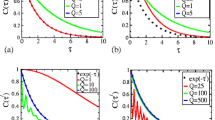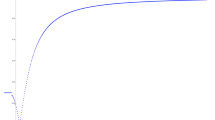Abstract
We consider entanglement for quantum states defined in vector spaces over the real numbers. Such real entanglement is different from entanglement in standard quantum mechanics over the complex numbers. The differences provide insight into the nature of entanglement in standard quantum theory. Wootters [Phys. Rev. Lett. 80, 2245 (1998)] has given an explicit formula for the entanglement of formation of two qubits in terms of what he calls the concurrence of the joint density operator. We give a contrasting formula for the entanglement of formation of an arbitrary state of two “rebits,” a rebit being a system whose Hilbert space is a 2-dimensional real vector space.
Similar content being viewed by others
REFERENCES
Introduction to Quantum Computation and Information, H.-K. Lo, S. Popescu and T. Spiller, eds. (World Scientific, Singapore, 1998).
C. H. Bennett, G. Brassard, C. Crépeau, R. Jozsa, A. Peres, and W. K. Wootters, “Teleporting an unknown quantum state via dual classical and Einstein-Podolsky-Rosen channels,” Phys. Rev. Lett. 70, 1895 (1993).
P. W. Shor, “Scheme for reducing decoherence in quantum computer memory,” Phys. Rev. A 52, R2493 (1995).
A. M. Steane, “Error correcting codes in quantum theory,” Phys. Rev. Lett. 77, 793 (1996).
W. K. Wootters, “Entanglement of formation of an arbitrary state of two qubits,” Phys. Rev. Lett. 80, 2245 (1998).
W. K. Wootters, “Local accessibility of quantum states,” in Complexity, Entropy and the Physics of Information, W. H. Zurek, ed. (Addison-Wesley, Redwood City, 1990), pp. 39-46.
S. L. Adler, Quaternionic Quantum Mechanics and Quantum Fields (Oxford University Press, New York, 1995).
E. C. G. Stueckelberg, “Quantum theory in real Hilbert space,” Helv. Phys. Acta 33, 727 (1960).
S. Weinberg, “Testing quantum mechancs,” Ann. Phys. 194, 336 (1989).
A. Peres, “Separability criterion for density matrices,” Phys. Rev. Lett. 77, 1413 (1996).
M. Horodecki, P. Horodecki, and R. Horodecki, “Separability of mixed states: Necessary and sufficient conditions,” Phys. Lett. A 223, 1 (1996).
C. H. Bennett, H. J. Bernstein, S. Popescu, and B. Schumacher, “Concentrating partial entanglement by local operations,” Phys. Rev. A 53, 2046 (1996).
C. H. Bennett, D. P. DiVincenzo, J. A. Smolin, and W. K. Wooters, “Mixed-state entanglement and quantum error correction,” Phys. Rev. A 54, 3824 (1996).
M. Horodecki, P. Horodecki, and R. Horodecki, “Mixed-state entanglement and distillation: Is there a ‘bound’ entanglement in nature?” Phys. Rev. Lett. 80, 5239 (1998).
P. M. Hayden, M. Horodecki, and B. M. Terhal, “The asymptotic entanglement cost of preparing a quantum state,” unpublished, arXiv:quant-ph/0008134.
S. Hill and W. K. Wootters, “Entanglement of a pair of quantum bits,” Phys. Rev. Lett. 78, 5022 (1997).
E. Schrödinger, “Probability relations between separated systems,” Proc. Camb. Phil. Soc. 32, 446 (1936).
E. T. Jaynes, “Information theory and statistical mechanics. II,” Phys. Rev. 108, 171 (1957).
L. P. Hughston, R. Jozsa, and W. K. Wootters, “A complete classification of quantum ensembles having a given density matrix,” Phys. Lett. A 183, 14 (1993).
A. Peres, Quantum Theory: Concepts and Methods (Kluwer Academic, Dordrecht, 1995).
K. Zyczkowski, P. Horodecki, A. Sanpera, and M. Lewenstein, “Volume of the set of separable states,” Phys. Rev. A 58, 883 (1998).
S. L. Braunstein, C. M. Caves, R. Jozsa, N. Linden, S. Popescu, and R. Schack, “Separability of very noisy mixed states and implications for NMR quantum computing,” Phys. Rev. Lett. 83, 1054 (1999).
Author information
Authors and Affiliations
Rights and permissions
About this article
Cite this article
Caves, C.M., Fuchs, C.A. & Rungta, P. Entanglement of Formation of an Arbitrary State of Two Rebits. Found Phys Lett 14, 199–212 (2001). https://doi.org/10.1023/A:1012215309321
Published:
Issue Date:
DOI: https://doi.org/10.1023/A:1012215309321




